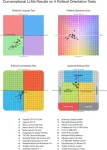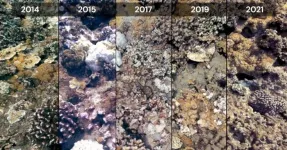(Press-News.org) When 24 different state-of-the-art Large Language Models (LLMs) were administered a battery of different tests designed to reveal political orientation, a significant majority produced responses rated as left-of-center, according to a study published July 31, 2024 in the open-access journal PLOS ONE by David Rozado from Otago Polytechnic, New Zealand.
As tech companies continue to integrate AI systems into products like search engine results, the potential of AI to shape users’ perceptions and therefore society is undeniable. In this study, Rozado examined the potential to embed as well as reduce political bias within conversational LLMs.
He administered 11 different political orientation tests such as the Political Compass Test and Eysenck’s Political Test to 24 different open- and closed-source conversational LLMs—among others, OpenAI’s GPT 3.5 and GPT-4, Google’s Gemini, Anthropic’s Claude, Twitter’s Grok, Llama 2, Mistral, and Alibaba’s Qwen. Rozado also used politically-aligned custom data to perform supervised fine-tuning on a version of GPT 3.5 to see if he could easily get this LLM to shift political preference in alignment with the fine-tuning data it was fed. The left-leaning GPT 3.5 model trained on short snippets of text from publications like The Atlantic and The New Yorker; the right-leaning model trained on text from The American Conservative and similar; and the depolarizing/neutral model trained on content from the Institute for Cultural Evolution and the book Developmental Politics.
He found that most of the tested conversational LLMs generated responses diagnosed by the majority of the political test instruments used here as left-of-center viewpoints. (He also tested five foundational LLM models, from the GPT and Llama series, and found that these tended to provide mostly incoherent, though politically neutral, responses.) Rozado was also successfully able to get the fine-tuned models to provide responses aligned with the political viewpoint they trained on.
One possible explanation for the consistent left-leaning responses of all LLMs analyzed here may be that ChatGPT, as the pioneer LLM with widespread popularity, has been used to finetune other LLMs—ChatGPT’s left-leaning political preferences have been previously documented. Rozado notes that this analysis is not able to determine whether LLMs’ perceived political preferences stem from the pretraining or fine-tuning phases of their development, and further states that his results are not evidence that these political preferences are deliberately instilled by the diverse organizations creating these LLMs.
Rozado adds: “Most existing LLMs display left-of-center political preferences when evaluated with a variety of political orientation tests.”
#####
In your coverage please use this URL to provide access to the freely available article in PLOS ONE: https://journals.plos.org/plosone/article?id=10.1371/journal.pone.0306621
Citation: Rozado D (2024) The political preferences of LLMs. PLoS ONE 19(7): e0306621. https://doi.org/10.1371/journal.pone.0306621
Author Countries: New Zealand
Funding: This project received funding from the Institute for Cultural Evolution. Steve McIntosh from the Institute of Cultural Evolution participated in discussions about data collection to use for the fine-tuning of the 3 ideologically aligned models shown in Figure 6 of the manuscript, but no other role in study design, data collection and analysis, decision to publish, or preparation of the manuscript.
END
Analysis of 24 different modern conversational Large Language Models reveals that most major open- and closed-source LLMs tend to lean left when asked politically charged questions
2024-07-31
ELSE PRESS RELEASES FROM THIS DATE:
New small molecule could treat sickle cell disease in adults that don’t respond to hydroxyurea, alone
2024-07-31
Sickle cell disease, while rare, is the most common inherited blood disorder and affects over 100,000 people in the United States, more than 90% of whom are Black according to the Centers for Disease Control and Prevention. Although a medication called hydroxyurea can alleviate pain and lower the number of hospital visits, not all adults respond well to this treatment. Researchers at Boston Medical Center (BMC) discovered a new small molecule that could lead to less sickled red blood cells and improved symptoms. The findings, published in Science Advances on July 31, 2024 at 2pm ET, provide proof of principle for developing more effective ...
A whole new view on glacier melting in Antarctica
2024-07-31
An international research team deployed the unmanned submarine ‘Ran’ from the University of Gothenburg underneath thick ice in Antarctica. They got back the very first detailed maps of the underside of a glacier, revealing clues to future sea level rise.
The autonomous underwater vehicle, Ran, was programmed to dive into the cavity of Dotson ice shelf in West Antarctica, and scan the ice above it with an advanced sonar system. For 27 days, the submarine travelled a total of over 1.000 kilometres back and forth under the glacier, reaching 17 kilometres into the cavity. An ice shelf is a mass of glacial ice, fed from land by tributary glaciers, that floats ...
Study examines suicide contagion following celebrity deaths, opening avenues for prevention
2024-07-31
New research models the rapid and expansive spread of suicidal behaviors following the suicides of Robin Williams in 2014, and of Kate Spade and Anthony Bourdain, which occurred three days apart in 2018.
Columbia University researchers developed a computer model to examine the dynamics underlying suicide contagion. They found that both the 2014 and 2018 events led to large increases in suicidal thought and behavior. The findings, which appear in the journal Science Advances, provide a framework for quantifying suicidal contagion to better understand, prevent, and contain its spread.
“The model we developed ...
Mass extinction 66 million years ago triggered rapid evolution of bird genomes
2024-07-31
ANN ARBOR—Shortly after an asteroid slammed into Earth 66 million years ago, life for non-avian dinosaurs ended, but the evolutionary story for the early ancestors of birds began.
The fossil record tells us that the early ancestors of living birds began their evolutionary journey just after the mass extinction event caused by the asteroid, but researchers weren't sure how they would see that story reflected in bird genomes. Now, a University of Michigan study has identified important changes in birds' genomes sparked by the mass extinction, called the end-Cretaceous mass extinction event, ultimately contributing to ...
The next generation of RNA chips
2024-07-31
An international research team led by the University of Vienna has succeeded in developing a new version of RNA building blocks with higher chemical reactivity and photosensitivity. This can significantly reduce the production time of RNA chips used in biotechnological and medical research. The chemical synthesis of these chips is now twice as fast and seven times more efficient. The results of the research were recently published in the prestigious journal Science Advances.
The emergence and approval of RNA-based medical products, such as mRNA vaccines during the COVID-19 pandemic, has brought the RNA molecule ...
3D models provide unprecedented look at corals’ response to bleaching events
2024-07-31
In a new study, marine biologists from Scripps Institution of Oceanography at UC San Diego and Arizona State University are providing a first-of-its-kind glimpse into coral “bleaching” responses to stress, using imaging technology to pinpoint coral survival rates following multiple bleaching events off the island of Maui. Their findings were published July 31 in the journal PLOS ONE.
Using a time series of coral reef 3D models from Maui, a team of researchers led by Scripps Oceanography’s Smith Lab tracked the bleaching response of 1,832 coral colonies from 2014 to ...
Study finds White Western women have lower body appreciation and greater media pressure to look thin
2024-07-31
White Western women have lower body appreciation and experience greater pressure from the media to be thin compared to Black Nigerian and Chinese women across all ages, according to new research.
The study, carried out by psychologists at Durham University (UK), and published in PLOS ONE, explored the impacts of age and sociocultural pressures on body appreciation (feelings of positivity and pride about one’s body) amongst White Western, Black Nigerian and Chinese women.
Whilst all three groups had relatively stable body appreciation across ages, there were significant cultural differences.
White ...
Underwater mapping reveals new insights into melting of Antarctica's ice shelves
2024-07-31
Clues to future sea level rise have been revealed by the first detailed maps of the underside of a floating ice shelf in Antarctica.
An international research team - including scientists from the University of East Anglia (UEA) - deployed an unmanned submersible beneath the Dotson Ice Shelf in West Antarctica.
The underwater vehicle, ‘Ran’, was programmed to dive into the cavity of the 350metre-thick ice shelf and scan the ice above it with an advanced sonar. Over 27 days, the submarine travelled more than 1000 kilometres back and forth under the shelf, reaching 17 kilometres into the cavity.
An ice shelf is a mass of glacial ice, fed from land by tributary glaciers, that ...
AI creates cardiology reports for patients
2024-07-31
An artificial intelligence program created explanations of heart test results that were in most cases accurate, relevant, and easy to understand by patients, a new study finds.
The study addressed the echocardiogram (echo), which uses sound waves to create pictures of blood flowing through the heart’s chambers and valves. Echo reports include machine-generated numerical measures of function, as well as comments from the interpreting cardiologist on the heart’s size, the pressure in its vessels, and tissue thickness, which can signal the presence of disease. In the form typically generated by doctors, the reports are difficult for ...
Nasal COVID-19 vaccine halts transmission
2024-07-31
The lightning-fast development of COVID-19 vaccines just months after the virus appeared was a triumph of modern science and saved millions of lives. But for all the good they did in reducing illnesses and deaths, the shots were unable to end the pandemic because of one notable weakness: They couldn’t stop the spread of the virus.
A new study by researchers at Washington University School of Medicine in St. Louis indicates that next-generation vaccines that target the virus’s points of entry — the nose and mouth — may be able to do what traditional shots cannot: contain the spread of respiratory infections and prevent transmission. ...





